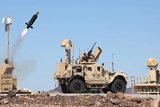New Turkish Kemankes loitering munition begins testing
The Kemankes 2 will be expected to be able to travel more than 200km. (Photo: Baykar video screengrab)
Turkish drone maker Baykar has begun testing its new jet-powered Kemankes 2 loitering munition. The news came less than a year after the Kemankes was test-fired from a TB2 UAV.
The new version was said to be AI-powered and the recent test was conducted with a launch from speed pickup.
Specific capabilities and details of the Kemankes 2 were not revealed, but a video (see below) released by the manufacturer provided a glimpse of its features. The new cruise missile loitering munition appeared to be significantly larger than its predecessor, the Kemankes, which weighed 30 kg with a capacity for 6kg warheads.
Parts of the missile, including the wing, the engine and the tail fins, closely resembled the KaGeM-V3 which was jointly developed with Pakistan.
Equipped with an unknown jet engine enabling rapid travel and boasting a one-hour flight duration, the Kemankes 2 was designed to conduct deep-strike missions on high-priority targets. Baykar has claimed it has a range of more than 200km.
While the first Kemankes has been designed to be air-launched from Baykar UAVs such as the Akinci, Bayraktar TB2 and Bayraktar TB3, it was not clear what launch options the Kemankes 2 would feature once fully developed.
Related Equipment in Defence Insight
More from Air Warfare
-
![BAE Systems reveals new GCAP demonstrator design with plans to fly by 2027]()
BAE Systems reveals new GCAP demonstrator design with plans to fly by 2027
A key part in the trinational Global Combat Air Programme (GCAP), this is the first crewed supersonic aircraft demonstrator to be built and developed in the UK in more than 40 years.
-
![Kratos Defense makes European CCA push with Airbus partnership]()
Kratos Defense makes European CCA push with Airbus partnership
Kratos’ XQ-58A Valkyrie will be equipped with an Airbus-made mission system to be offered as a ‘European’ collaborative combat aircraft option to the German Air Force.
-
![Anduril’s Barracuda-100M completes latest successful test flights]()
Anduril’s Barracuda-100M completes latest successful test flights
The munitions variant of the Barrauda-100 autonomous air vehicle is being tested for the US Army’s High-Speed Manoeuvrable Missile (HSMM) testbed programme, with further flight tests expected in 2026.





















